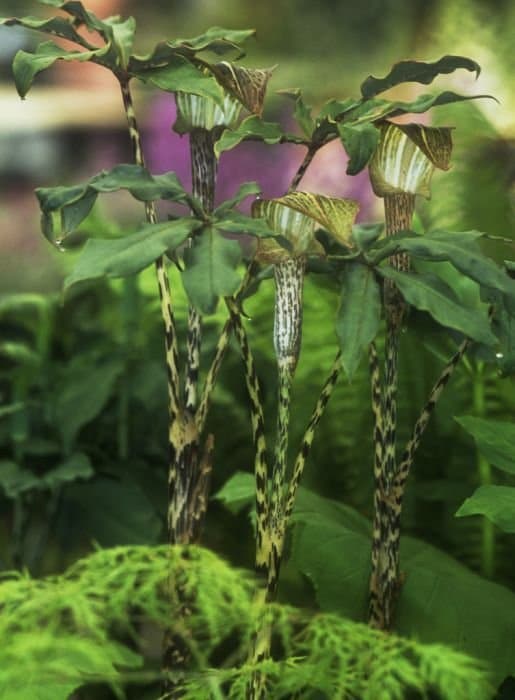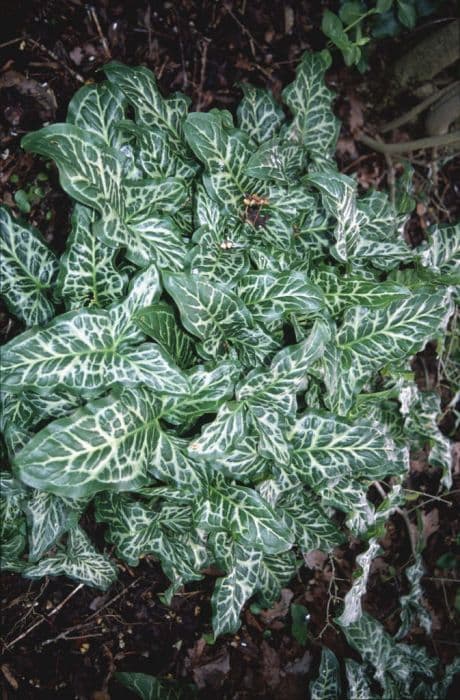Calla Lily 'Captain Romance' Zantedeschia 'Captain Romance' (PBR) (Captain Series)

ABOUT
The plant known as Zantedeschia 'Captain Romance', which is part of the Captain Series, is characterized by its striking appearance. It showcases vibrant, trumpet-shaped flowers that exude a sense of elegance and romance. These blooms come in a rich hue that is often a deep pink, adding a bold splash of color to any garden space. The flowers curve gracefully, emanating from the base and extending upwards, encapsulating a sense of fluid motion. Surrounding the flowers are lush, green leaves that create a striking contrast with their vibrant backdrop. The foliage is wide and has an arrow-like shape, providing a robust and healthy foundation for the delicate flowers above. These leaves may occasionally display spotted or blushed patterns, which further enhances the visual interest of the plant. Notably, this variety exudes a subtle and pleasing fragrance, which can attract admirers as well as pollinators such as bees and butterflies. Overall, the 'Captain Romance' plant presents itself as a captivating and statuesque addition to ornamental gardens and vibrant floral displays.
About this plant
 Names
NamesFamily
Araceae
Synonyms
Calla Lily, Arum Lily
Common names
Zantedeschia 'Captain Romance' (PBR) (Captain Series)
 Toxicity
ToxicityTo humans
Calla Lily, which is the common name of Zantedeschia 'Captain Romance', holds a degree of toxicity to humans. The plant contains calcium oxalate crystals, which are not uncommon in the plant kingdom but can be irritating and harmful if ingested. If someone eats any part of a Calla Lily, they could experience symptoms such as a burning sensation in the mouth and throat, swelling of lips, tongue, and throat leading to difficulty in swallowing, and possible vomiting or diarrhea. It is important to keep this plant out of reach from children who might be tempted to chew on it, due to its potential to cause discomfort and these unpleasant symptoms.
To pets
Calla Lily, the common name of Zantedeschia 'Captain Romance', is toxic to pets as well. Similar to their effect in humans, these plants contain calcium oxalate crystals that can irritate pets’ mouth and gastrointestinal tract when ingested. Symptoms of Calla Lily poisoning in pets can include drooling, vomiting, difficulty swallowing, and a decrease in appetite due to the painful irritation in the mouth and throat. Oral irritation can lead to pawing at the face and visible swelling of the lips, tongue, or throat. It is critical to prevent pets from accessing or ingesting any part of the plant to avoid these symptoms and potential health issues.
 Characteristics
CharacteristicsLife cycle
Perennials
Foliage type
Deciduous
Color of leaves
Green
Flower color
Pink
Height
2 feet (60 cm)
Spread
1 feet (30 cm)
Plant type
Herb
Hardiness zones
8
Native area
South Africa
Benefits
 General Benefits
General Benefits- Ornamental Display: Calla Lily 'Captain Romance' has striking trumpet-shaped flowers in a beautiful pink hue, which add elegance and a splash of color to gardens and indoor spaces.
- Long Blooming Period: This variety often enjoys an extended blooming season, providing floral interest for a longer time compared to other garden plants.
- Easy to Grow: Calla Lilies are known for being low maintenance, making them suitable for gardeners of all skill levels.
- Container Gardening: Due to its moderate size, 'Captain Romance' is well-suited for container gardening, allowing for versatility in placement and relocation.
- Versatile Landscaping: The plant works well in various garden designs, including borders, beds, and as a focal point due to its unique appearance.
- Cut Flowers: The blossoms of this Calla Lily are long-lasting when cut, making them perfect for arrangements and bouquets.
- Attracts Pollinators: The flowers can attract bees and butterflies, which are beneficial for pollination in the garden ecosystem.
- Drought Tolerance: Once established, Calla Lilies can exhibit some drought tolerance, making them suitable for drier climates or water-conserving gardens.
 Medical Properties
Medical PropertiesThis plant is not used for medical purposes.
 Air-purifying Qualities
Air-purifying QualitiesThis plant is not specifically known for air purifying qualities.
 Other Uses
Other Uses- Photography Prop: Calla lilies, with their sophisticated form, are often used by photographers as a subject to create visually stunning images or as a prop in portrait and wedding photography.
- Artistic Inspiration: The elegant shape of calla lilies often inspires artists in their work, making them a classic muse for paintings, sculptures, and other forms of artwork.
- Education and Demonstration: Calla lilies are used to teach botany students about plant structure and reproduction due to their clear differentiation of plant parts.
- Craft Projects: The sturdy stems and distinct flowers can be incorporated into various crafts, such as homemade wreaths and floral arrangements for home decor.
- Performance Art: Due to their striking presence, calla lilies can be used as part of set designs in theater performances or dance recitals to add elegance to the stage.
- Culinary Presentation: While not edible, calla lilies can be used as a non-toxic garnish for plating and presentation in high-end culinary settings.
- Cultural Ceremonies: In some cultures, calla lilies have symbolic importance and are used in ceremonial practices and traditional events.
- Surface Printing: The distinctive shape of calla lilies makes them a popular choice for patterns in textile design and surface printmaking.
- Garden Design: Calla lilies can be grown in water gardens alongside other aquatic plants, providing a touch of elegance and color contrast.
- Fashion Accessories: The blooms are sometimes used to create unique, floral-themed jewelry or accessory pieces like hairpins and brooches.
Interesting Facts
 Feng Shui
Feng ShuiThe Calla Lily is not used in Feng Shui practice.
 Zodiac Sign Compitability
Zodiac Sign CompitabilityThe Calla Lily is not used in astrology practice.
 Plant Symbolism
Plant Symbolism- Purity and innocence: The calla lily, which Zantedeschia 'Captain Romance' belongs to, is commonly associated with purity and innocence due to its clean, elegant bloom shape and color.
- Beauty: The smooth, trumpet-shape and vibrant color of the calla lily represents magnificent beauty.
- Faith and devotion: In Christian symbolism, the calla lily has been used to represent faith and devotion.
- Rebirth and resurrection: The calla lily is often used during Easter and associated with Jesus's resurrection due to its shape reminiscent of a trumpet, heralding a new beginning.
- Marriage and fidelity: Due to its beauty and form, the calla lily is often used in wedding bouquets symbolizing the purity of the marital union and lasting fidelity.
 Water
WaterThe Calla Lily, known as 'Captain Romance', prefers soil that is consistently moist but well-drained. During the growing season, water the plant thoroughly once a week with approximately 0.5 gallons of water, ensuring that the water penetrates deeply into the soil to reach the roots. Adjust frequency based on weather conditions—more often during hot, dry periods, and less during cool, rainy spells. Always allow the top inch of soil to dry out before watering again to prevent overwatering, which can lead to root rot. In winter, reduce watering to every other week, as the plant requires less moisture during dormancy.
 Light
LightThe Calla Lily 'Captain Romance' thrives in partial shade to full sun. It performs best when it receives at least six hours of morning sunlight and is protected from the intense heat of the afternoon. A spot that offers bright, indirect light is ideal, as too much direct sunlight can scorch the leaves. Indoors, place the plant near a window where it can get plenty of natural light without being in the direct path of the sun's rays.
 Temperature
TemperatureThe Calla Lily 'Captain Romance' prefers temperatures between 65 to 75 degrees Fahrenheit for optimal growth. It can survive temperatures as low as 50 degrees Fahrenheit, but should not be exposed to temperatures below this, as it can cause damage to the plant. During the growing season, maintain a consistent temperature within the ideal range, avoiding drafts and sudden temperature fluctuations. The plant is not frost-tolerant and should be moved indoors or protected when temperatures start to approach the minimum threshold.
 Pruning
PruningPruning the Calla Lily 'Captain Romance' is mainly about removing spent flowers and yellowing leaves to encourage new growth and maintain the plant's appearance. Trim away faded blooms and any discolored foliage with clean, sharp shears. The best time for pruning is after flowering has concluded in late summer or early fall. Pruning is not frequently required, but occasional tidying can keep the plant healthy and attractive.
 Cleaning
CleaningAs needed
 Soil
SoilCalla lily 'Captain Romance' thrives in well-draining, rich, and slightly acidic soil with a pH of around 5.5 to 6.5. A mix containing peat, perlite, and compost is ideal for providing the necessary nutrients and drainage.
 Repotting
RepottingCalla lily 'Captain Romance' should be repotted every two years or when the rhizomes outgrow the current pot, to ensure it has enough room to grow and to refresh the soil.
 Humidity & Misting
Humidity & MistingCalla lily 'Captain Romance' prefers high humidity levels, ideally between 60% to 70%, to maintain its vibrant foliage and promote healthy growth.
 Suitable locations
Suitable locationsIndoor
Place in bright, indirect light.
Outdoor
Plant in partial shade, sheltered.
Hardiness zone
8-10 USDA
 Life cycle
Life cycleZantedeschia 'Captain Romance', commonly known as Captain Romance calla lily, begins its life cycle as a rhizomatous tuber planted in early spring. After planting, it typically emerges when soil temperatures are warm enough, producing lance-shaped leaves and elegant chalice-like flowers that usually bloom in late spring to early summer. The flowers last for several weeks before they fade, and the plant then directs energy back into the rhizome to store nutrients for the next growing season. Following the flowering stage, the leaves continue photosynthesis throughout the summer to gather energy before they yellow and die back in autumn as the plant enters dormancy. Over winter, the tuber rests in the soil until conditions are favorable again. In cultivation, tubers are often lifted and stored dry over winter in colder climates to prevent freezing, then replanted the following spring to start the cycle anew.
 Propogation
PropogationPropogation time
Spring to Summer
Zantedeschia 'Captain Romance', commonly known as Captain Romance calla lily, is typically propagated via division, a process best undertaken in late winter or early spring just before the growing season begins. To propagate by division, gently lift the rhizomes from the soil after the foliage has died back. Clean any excess soil and divide the rhizomes by carefully breaking them apart at natural division points, making sure each section has at least one growth point or "eye." Plant the divisions at a depth of about 3 to 4 inches (approximately 7.6 to 10.2 centimeters) in well-draining soil and spaced around 12 to 18 inches (about 30 to 45 centimeters) apart to allow space for growth. Water the newly planted divisions thoroughly and maintain consistently moist soil as the new plants establish themselves.









